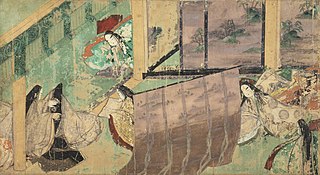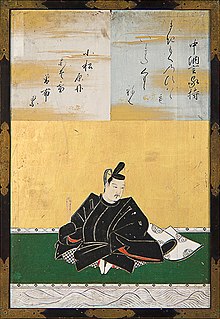Sakanoue no Mochiki(坂上望城, dates unknown, likely died around 975 [1] ) was a Heian period waka poet and Japanese nobleman. He was the son of Sakanoue no Korenori, one of the Thirty-six Poetry Immortals. [1]

The Heian period is the last division of classical Japanese history, running from 794 to 1185. The period is named after the capital city of Heian-kyō, or modern Kyōto. It is the period in Japanese history when Buddhism, Taoism and other Chinese influences were at their height. The Heian period is also considered the peak of the Japanese imperial court and noted for its art, especially poetry and literature. Although the Imperial House of Japan had power on the surface, the real power was in the hands of the Fujiwara clan, a powerful aristocratic family who had intermarried with the imperial family. Many emperors actually had mothers from the Fujiwara family. Heian (平安) means "peace" in Japanese.

Waka is a type of poetry in classical Japanese literature. Waka are composed in Japanese, and are contrasted with poetry composed by Japanese poets in Classical Chinese, which are known as kanshi. Although waka in modern Japanese is written as 和歌, in the past it was also written as 倭歌, and a variant name is yamato-uta (大和歌).

Sakanoue no Korenori (坂上是則) was a Japanese waka poet of the early Heian period. His exact dates of birth and death are unknown, but he was a fourth-generation descendant of Sakanoue no Tamuramaro.
As one of the Five Men of the Pear Chamber (梨壺の五人), he contributed to the compilation of the Gosen Wakashū . [1] He also compiled kundoku (訓読) readings for texts from the Man'yōshū . [1]
The Five Men of the Pear Chamber are a group of Heian period Japanese poets and scholars who cooperated in the compilation of the Gosen Wakashū. They also compiled kundoku (訓読) readings for texts from the Man'yōshū. The group was composed of the following men:

The Gosen Wakashū, often abbreviated as Gosenshū, is an imperial anthology of Japanese waka compiled in 951 at the behest of Emperor Murakami by the Five Men of the Pear Chamber: Ōnakatomi no Yoshinobu (922-991), Kiyohara no Motosuke (908-990), Minamoto no Shitagō (911-983), Ki no Tokibumi, and Sakanoue no Mochiki. It consists of twenty volumes containing 1,426 poems.
The Man'yōshū is the oldest existing collection of Japanese poetry, compiled sometime after AD 759 during the Nara period. The anthology is one of the most revered of Japan's poetic compilations. The compiler, or the last in a series of compilers, is today widely believed to be Ōtomo no Yakamochi, although numerous other theories have been proposed. The last datable poem in the collection is from AD 759 (No. 4516). It contains many poems from much earlier, many of them anonymous or misattributed, but the bulk of the collection represents the period between AD 600 and 759. The precise significance of the title is not known with certainty.










